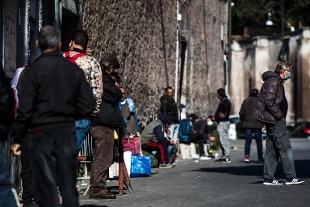- Save the Children, children squeezed between growing poverty and scarce opportunities
- 500 million people at risk of poverty from coronavirus, says Oxfam
- Istat: household income increases (+ 2.6%) but 20.3% at risk of poverty
- OECD: one in seven children in poverty, Italy above average
- Eurostat. In Campania 41.4% of the population at risk of poverty, top EU
Share
May 16, 2020 A good portion of the Italian population is at risk of poverty and social exclusion. This is what emerges from the Istat report on the 2020 Sustainable Development Goals. In Italy, in 2018, the population at risk of poverty or social exclusion was equal to 27.3% (about 16 million and 400 thousand individuals), decreasing compared to the previous year (28.9%). However, the Italian level remains higher than the European one (21.7% in 2018 from 22.4% in 2017).The data before Covid-19
The dissemination of the third edition of the Report on Sustainable Development Goals (SDGs) takes place in the presence of the Covid-19 pandemic which has accelerated the need for a unified vision capable of developing and implementing an appropriate strategy for careful economic, social and environmental development interdependencies of different aspects and oriented towards sustainability. The Report mainly contains information updated to 2019, but also sought to account for the impact of Covid-19 with a counterfactual assessment exercise starting from the lockdown.
6.5% of families in absolute poverty
Even analyzing the three indicators that make up the risk of poverty or social exclusion, the situation in 2018 (2017 income) is improving, with the exception of the risk of poverty, which concerns 20.3% of the population and is stable compared to 2017 (2016 income); the severe material deprivation decreased (8.5% in 2018, from 10.1% in 2017), and the share of those who live in families with a very low work intensity (11.3% from 11.8%). Progress in reducing poverty in Italy is confirmed in 2019: the incidence of absolute poverty concerns 6.5% of families and 7.8% of individuals (7.8% and 8.4% in 2018).
Per capita GDP slows
On purely economic data, the report states that after the recovery in the period 2015-2017, the last two years show a slowdown in per capita GDP growth, more pronounced in 2019 (+ 0.4%). But in recent years, the continuation of the positive phase of the economic cycle has led to a generalized improvement in employment and a reduction in unemployment both in European countries and, to a lesser extent, in Italy.
The poor increasingly poor
The report also shows that in Italy, in the period 2004-2017, the growth of incomes of the relatively low-income population has undergone a marked deterioration. In particular, in 2017 the incomes of the entire population increased more than the incomes of the poorest people (respectively + 1.6% and + 0.2%). In the Peninsula, the percentage of disposable income for 40% of the poorest population (19.3%) is lower than the European average (20.9%, 2016 data).
Immigration
Meanwhile, on the emigration front, according to Istat, 242,009 new residence permits were issued in 2018, 7.9% less than the previous year. The decrease is largely attributable to the drop in permits issued for asylum applications. The presence of refugees remains low (less than 1% of permits valid on 1st January 2019). Acquisitions of citizenship continue to decrease: in 2018 there were 103,485, 23.8% less than in 2017.
Housing
The report also photographs the situation of housing conditions; the unsatisfactory ones involve more than a quarter of the Italian population. Sore notes also on the education front. In 2018 in Italy the percentage of students who do not reach the minimum level of scientific competence reaches 25.9%, which is significantly worse than the OECD average (22%).
Training
The percentage of young people between 18 and 24 years old who have not completed their schooling and training is 13.5% in 2019, a decrease compared to the 2017-2018 two-year period. Also in 2019, only 27.6% of young people aged 30-34 have a university degree or tertiary qualification (33.8% of women and 21.6% of men), stable compared to 2018. The level remains significantly below average European (41.3%). The participation of Italian adults in formal and non-formal training activities remains constant between 2018 and 2019: 8.1% of those aged between 25 and 64 have carried out at least one training activity in the last 4 weeks.
Research
On research Italy lags behind other countries. The average research intensity of the European Union, measured with respect to GDP, went from 1.93 in 2009 to 2.12 in 2018, a value which is still far from the Europe 2020 target.

